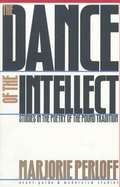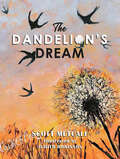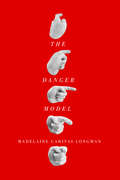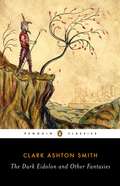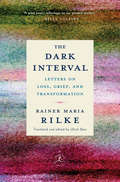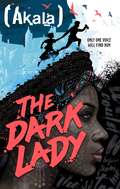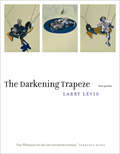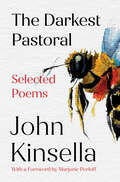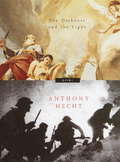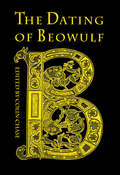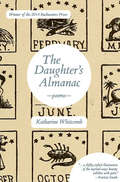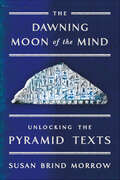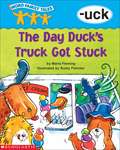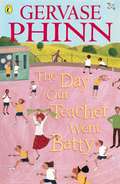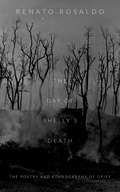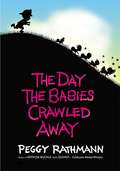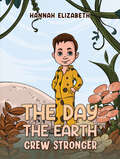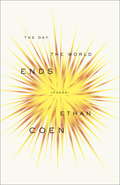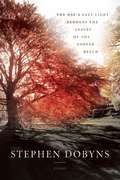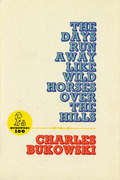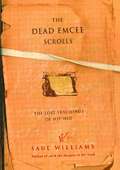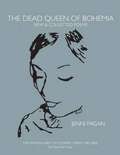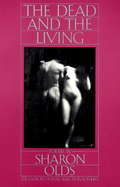- Table View
- List View
The Dance of the Intellect: Studies in the Poetry of the Pound Tradition
by Marjorie PerloffMust poetic form be, as Yeats demanded, "full, sphere-like, single", or can it accommodate the "impurities" Yeats and his Modernist generation found so problematic? Sixty years later, these are still open questions, questions to which Marjorie Perloff addresses herself in the essays collected here. The first group of essays deals with Pound's own poetics as that poetics related to two of his great contemporaries, Stevens and Joyce, as well as to the visual arts of his day. The second group deals with the more technical aspects of verse and prose. In the last four essays, Perloff takes up broader issues, including the current pessimism about the state of poetry, and the work of experimental poets and conceptual poets.
The Dandelion's Dream
by Scott MetcalfHave you ever had a dream that you did something amazing that in reality would be impossible? Well, wait until you see what happens to the little dandelion and her amazing dream! Children of all ages will be delighted by this heartwarming and inspiring story and the colorful illustrations that accompany it. Sure to become a bedtime favorite for generations. Believe in your dreams!
The Danger Model (Hugh MacLennan Poetry Series #49)
by Madelaine Caritas LongmanIs the self inside the body / or is it the body / or can it leave? "How can you ask a question that you live inside?" Madelaine Caritas Longman's debut is an affecting, intelligent engagement with the often-paradoxical pursuit of self-coherence and self-presence. These prose poems, haiku, and experiments with language and form not only examine the individual search for identity but call into question the concept itself. Inhabiting contexts as diverse as the medical system, performance art, queer adolescence, and Talmudic debate, The Danger Model considers what it means to be a "self." Searching for answers in Internet forums, the work of Portuguese poet Fernando Pessoa, and the films and installations of Japanese artist Yayoi Kusama, Longman brings attention to the lived experience of mental and physical illness and attempts to make meaning out of it. Disarmingly candid, intellectually rigorous, and surprisingly funny, these poems explore the luxury and burden of subjectivity by showing us what it is like to struggle to attach oneself to the world through specific desires and needs. Provocatively realistic but also hopeful, The Danger Model is an investigation of how we come to recognize – or not recognize – ourselves and each other.
The Danger Model (Hugh MacLennan Poetry Series #51)
by Madelaine Caritas LongmanIs the self inside the body / or is it the body / or can it leave? "How can you ask a question that you live inside?" Madelaine Caritas Longman's debut is an affecting, intelligent engagement with the often-paradoxical pursuit of self-coherence and self-presence. These prose poems, haiku, and experiments with language and form not only examine the individual search for identity but call into question the concept itself. Inhabiting contexts as diverse as the medical system, performance art, queer adolescence, and Talmudic debate, The Danger Model considers what it means to be a "self." Searching for answers in Internet forums, the work of Portuguese poet Fernando Pessoa, and the films and installations of Japanese artist Yayoi Kusama, Longman brings attention to the lived experience of mental and physical illness and attempts to make meaning out of it. Disarmingly candid, intellectually rigorous, and surprisingly funny, these poems explore the luxury and burden of subjectivity by showing us what it is like to struggle to attach oneself to the world through specific desires and needs. Provocatively realistic but also hopeful, The Danger Model is an investigation of how we come to recognize - or not recognize - ourselves and each other.
The Dark Eidolon and Other Fantasies
by Clark Ashton Smith S. T. JoshiA much-awaited collection of prose and poetry from one of the great cosmic masters of the supernatural Not just any fantasy, horror, and science fiction author could impress H. P. Lovecraft into calling him "unexcelled by any other writer, dead or living" or compel Fritz Lieber to employ the worthy term sui generis. Clark Ashton Smith--autodidact, prolific poet, amateur philosopher, bizarre sculptor, and unmatched storyteller--simply wrote like no one else, before or since. This new collection of his very best tales and poems is selected and introduced by supernatural literature scholar S. T. Joshi and allows readers to encounter Smith's visionary brand of fantastical, phantasmagorical worlds, each one filled with invention, terror, and a superlative sense of metaphysical wonder.
The Dark Interval: Letters on Loss, Grief, and Transformation (Modern Library Classics)
by Rainer Maria Rilke Ulrich BaerFrom the writer of the classic Letters to a Young Poet, reflections on grief and loss, collected and published here in one volume for the first time.“A great poet’s reflections on our greatest mystery.”—Billy Collins Gleaned from Rainer Maria Rilke’s voluminous, never-before-translated letters to bereaved friends and acquaintances, The Dark Interval is a profound vision of the mourning process and a meditation on death’s place in our lives. Following the format of Letters to a Young Poet, this book arranges Rilke’s letters into an uninterrupted sequence, showcasing the full range of the great author’s thoughts on death and dying, as well as his sensitive and moving expressions of consolation and condolence.Presented with care and authority by master translator Ulrich Baer, The Dark Interval is a literary treasure, an indispensable resource for anyone searching for solace, comfort, and meaning in a time of grief.Advance praise for The Dark Interval “Even though each of these letters of condolence is personalized with intimate detail, together they hammer home Rilke’s remarkable truth about the death of another: that the pain of it can force us into a ‘deeper . . . level of life’ and render us more ‘vibrant.’ Here we have a great poet’s reflections on our greatest mystery.”—Billy Collins “As we live our lives, it is possible to feel not sadness or melancholy but a rush of power as the life of others passes into us. This rhapsodic volume teaches us that death is not a negation but a deepening experience in the onslaught of existence. What a wise and victorious book!”—Henri Cole
The Dark Lady
by AkalaA natural storyteller with a vision of his own, THE DARK LADY, Akala's debut novel for teens will enthuse and entertain teenagers and young adults, showing that reading is a true super-power. A PICKPOCKET WITH AN EXCEPTIONAL GIFTA PRISONER OF EXTRAORDINARY VALUE AN ORPHAN HAUNTED BY DREAMS OF THE MYSTERIOUS DARK LADYHenry is an orphan, an outsider, a thief. He is also a fifteen-year-old invested with magical powers ...This brilliant, at times brutal, first novel from the amazing imagination that is Akala, will glue you to your seat as you are hurled into a time when London stank and boys like Henry were forced to find their own route through the tangled streets and out the other side.
The Darkening Trapeze: Last Poems
by Larry LevisThe empty bar that someone was supposed to swing to himDid not arrive, & so his outstretched flesh itself becameA darkening trapeze. The two other acrobats were thieves. --from "Elegy with a Darkening Trapeze Inside It"The Darkening Trapeze collects the last poems by Larry Levis, written during the extraordinary blaze of his final years when his poetry expanded into the ambitious operatic masterpieces he is known for. Edited and with an afterword by David St. John and published twenty years after Levis's death, this collection contains major unpublished works, including final elegies, brief lyrics, and a coda believed to be the last poem Levis wrote, a heart-wrenching poem about his son. The Darkening Trapeze is an astonishing collection by a poet many consider to be among the greatest of late-twentieth-century American poetry.
The Darkest Pastoral: Selected Poems
by John KinsellaOne of Australia’s most treasured poets draws on the past to reckon with the perils of the present. Illuminated by the spirit of ecological activism and decolonization, The Darkest Pastoral engages deeply with nature, climate catastrophe, and grief, and the interconnectedness between humans and the natural world. John Kinsella’s poetry stretches and often breaks the lyric in an attempt to create new modes of intervention and action. Though focused around his homeplace in the Western Australian wheatbelt, much of his poetry converses with other places around the world, especially those he has lived in for extended periods of time, including central Ohio; Cambridge, England; West Cork, Ireland; and southern Germany Often writing in an anti-pastoral mode, Kinsella experiments with the histories of poetry, art, and music, to create a poetry that will respect ecologies and bring positive changes in destructive human behaviors. His poetry, both experimental and pastoral, about the natural world is centrally preoccupied with birds and plants, and often features the landscape of Western Australia. Kinsella’s artistic response to ecological catastrophe is in dynamic conversation with the work of many artists and writers—Andy Warhol, Jackson Pollock, Helen Frankenthaler, and Jacques Derrida, among others. With acuity and empathy, this collection is a poetic attempt to reckon with a world in transition. “These are great ecological poems, whose wide sweep becomes increasingly astonishing as the years go by. At this writing, John Kinsella is a mere sixty. Who knows what is yet to come?”—from the foreword by Marjorie Perloff
The Darkness and the Light
by Anthony HechtThe poetry of Anthony Hecht has been praised by Harold Bloom and Ted Hughes, among others, for its sure control of difficult material and its unique music and visual precision. This new volume is the fruit of a mellowing maturity that carries with it a smoky bitterness, a flavor of ancient and experienced wisdom, as in this stanza from "Sarabande on Attaining the Age of Seventy-seven":A turn, a glide, a quarter-turn and bow,The stately dance advances; these are airsBone-deep and numbing as I should know by now,Diminishing the cast, like musical chairs. Hecht's verse--by turns lyric and narrative, formal and free--is grounded in the compassion that comes from a deep understanding of every kind of human depredation, yet is tempered by flashes of wry comedy, and still more by innocent pleasure in the gifts of the natural world. Followers of his poetry will recognize an evolution of style in many of these poems--a quiet and understated voice, passing through darkness toward realms of delight.From the Hardcover edition.
The Dating of Beowulf
by Colin ChaseThe date of Beowulf, debated for almost a century, is a small question with large consequences. Does the poem provide us with an accurate if idealized view of early Germanic culture? Or is it rather a creature of nostalgia and imagination, born of the desire of a later age to create for itself a glorious past? If we cannot decide when, between the 5th and 11th centuries, the poem was composed, we cannot distinguish what elements in Beowulf belong properly to the history of material culture, to the history of myth and legend, to political history, or to the development of the English literary imagination.This book represents both individual and concerted attempts to deal with this important question, and presents one of the most important inconclusions in the study of Old English. The contributors raise so many doubts, turn up so much new and disturbing information, dismantle so many long-accepted scholarly constructs that Beowulf studies will never be the same: henceforth every discussion of the poem and its period will begin with reference to this volume.
The Daughter's Almanac (The Backwaters Prize in Poetry)
by Katharine Whitcomb"With unflinching stanzas threaded through with grief's relentless lyric, THE DAUGHTER'S ALMANAC is a masterwork, a deftly crafted illustration of the myriad ways beauty collides with pain. Succinct and utterly memorable, these poems take hold of the heart and tug it toward an insistent light. We are washed alive in that light. We are changed by it."—Patricia Smith, 2014 Backwaters Prize Judge
The Dawning Moon of the Mind: Unlocking the Pyramid Texts
by Susan Brind MorrowA stunning and original interpretation of an ancient system of poetic, religious, and philosophical thoughtBuried in the Egyptian desert some four thousand years ago, the Pyramid Texts are among the world’s oldest poetry. Yet ever since the discovery of these hieroglyphs in 1881, they have been misconstrued by Western Egyptologists as a garbled collection of primitive myths and incantations, relegating to obscurity their radiant fusion of philosophy, scientific inquiry, and religion. Now, in a seminal work, the classicist and linguist Susan Brind Morrow has recast the Pyramid Texts as a coherent work of art, arguing that they should be recognized as a formative event in the evolution of human thought. In The Dawning Moon of the Mind she explains how to read hieroglyphs, contextualizes their evocative imagery, and interprets the entire poem. The result is a magisterial religious and philosophical text revealing a profound consciousness of the world with astonishing parallels to Judeo-Christian culture, Buddhism, and Tantra. More than twenty years in the making, The Dawning Moon of the Mind is a monumental achievement that locates one of the origins of poetic thought in Western culture. Almost before science, art, and written language, these texts set forth the relationship between time and eternity, life and death, history and ideas. In The Dawning Moon of the Mindthey emerge in their original luminosity and intelligence alongside a persuasive argument for their central importance to the history of language.
The Day Duck's Truck Got Stuck (Word Family Tales™ -uck)
by Rusty Fletcher Maria FlemingWord Family Tales are humorous read-aloud stories created to build early phonics skills by teaching children to recognize "families" of words that share the same spelling pattern. This key reading strategy helps kids decode new words with ease--and become stronger readers, writers, and spellers. Set learners on the path to literacy success with these rib-tickling tales--one for each of the top 25 word families! For use with Grades PreK-2.
The Day Our Teacher Went Batty
by Gervase PhinnA second collection of poems based on familiar themes.....
The Day of Shelly’s Death: The Poetry and Ethnography of Grief
by Renato RosaldoThis deeply moving collection of poetry by Renato Rosaldo focuses on the shock of his wife Michelle (Shelly) Rosaldo's sudden death on October 11, 1981. Just the day before, Shelly and her family had arrived in the northern Philippine village of Mungayang, where she and her husband Renato, both accomplished anthropologists, planned to conduct fieldwork. On October 11, Shelly died after losing her footing and falling some sixty feet from a cliff into a swollen river. Renato Rosaldo explored the relationship between bereavement and rage in his canonical essay, "Grief and a Headhunter's Rage," which first appeared in 1984 and is reprinted here. In the poems at the heart of this book, he returns to the trauma of Shelly's death through the medium of free verse, maintaining a tight focus on the events of October 11, 1981. He explores not only his own experience of Shelly's death but also the imagined perspectives of many others whose lives intersected with that tragic event and its immediate aftermath, from Shelly herself to the cliff from which she fell, from the two young boys who lost their mother to the strangers who carried and cared for them, from a tricycle taxi driver, to a soldier, to priests and nuns. Photographs taken years earlier, when Renato and Shelly were conducting research across the river valley from Mungayang, add a stark beauty. In a new essay, "Notes on Poetry and Ethnography," Rosaldo explains how and why he came to write the harrowing yet beautiful poems in The Day of Shelly's Death. More than anything else though, the essay is a manifesto in support of what he calls antropoesía, verse with an ethnographic sensibility. The essay clarifies how this book of rare humanity and insight challenges the limits of ethnography as it is usually practiced.
The Day the Babies Crawled Away
by Peggy RathmannWhat a lovely day at the fair. Children lining up for pony rides . . . moms and dads in a pie-eating contest . . . babies chasing butterflies . . . babies heading for the trees . . . I SAY! Where are those babies GOING? Only a small boy sees them leaving and follows as the babies chase butterflies in trees, frogs in a bog, even bats in a cave, ignoring pleas to come back. But not to worry, our hero saves the day, making sure that all the babies get home safely from their appealing adventures. Caldecott Medal winner Peggy Rathmann has created a highly original story told in a lilting text and a bold new style with classic black silhouettes against stunning skies of many colors that change and glow as afternoon turns into evening.
The Day the Earth Grew Stronger
by Hannah ElizabethThe Day the Earth Grew Stronger is an engaging short story offering bereavement support and guidance for parents and guardians of young children. The story provides a strong foundation for opening difficult conversations around the theme of death, helping children to better understand the concept. While many people choose to believe in heaven, The Day the Earth Grew Stronger provides a unique angle of belief and how a person’s body or soul is passed back through the earth and lives on through nature. The story approaches death in a direct yet sensitive manner; providing both explanation and comfort, and provides a safe space for children to process grief and loss.
The Day the World Ends
by Ethan CoenFrom one of the most inventive and celebrated filmmakers of the twentieth century, and co-creator of such classics as Fargo, No Country for Old Men, and True Grit, a collection of poems that offers humor and insight into an artist who has always pushed the boundaries of his craft.Ethan Coen's screenplays have surprised and delighted international audiences with their hilarious vision and bizarrely profound understanding of human nature. This eccentric genius is revealed again in The Day the World Ends, a remarkable range of poems that are as funny, ribald, provocative, raw, and often touching as the brilliant films that have made the Coen brothers cult legends.
The Day's Last Light Reddens the Leaves of the Copper Beech
by Stephen DobynsThis new collection from best-selling poet and novelist Stephen Dobyns focuses on the hard, ephemeral truth of mortality, and includes the section "Sixteen Sonnets for Isabel" about the recent death of his wife. In true Dobyns fashion, these poems grip and guide readers into a state of empathy, raising the question of how one lives and endures in the world.
The Days Run Away like Wild Horses
by Charles BukowskiThe Days Run Away like Wild Horses is a book of poems written by Charles Bukowski for Jane, his first love. These poems explore a more emotional side to the author.
The Dead Emcee Scrolls: The Lost Teachings of Hip-Hop
by Saul WilliamsIn the underground labyrinths of New York City's subway system, beneath the third rail of a long forgotten line, Saul Williams discovered scrolls of aged yellowish-brown paper rolled tightly into a can of spray paint. His quest to decipher this mystical ancient text resulted in a primal understanding of the power hip-hop has to teach us about ourselves and the universe around us. Now, for the first time, Saul Williams shares with the world the wonder revealed to him by the Dead Emcee Scrolls. I have paraded as a poet for years now. In the proc ess of parading I may have actually become one, but that's another story, another book. This book is a book that I have been waiting to finish since 1995. This is the book that finished me. The story I am about to tell may sound fantastic. It may anger some of you who have followed my work. You may feel that you have come to know me over the years, and in some cases you have, but in others...well, this is a confession.
The Dead Emcee Scrolls: The Lost Teachings of Hip-hop
by Saul WilliamsIn the underground labyrinths of New York City's subway system, beneath the third rail of a long forgotten line, Saul Williams discovered scrolls of aged yellowish-brown paper rolled tightly into a can of spray paint. His quest to decipher this mystical ancient text resulted in a primal understanding of the power hip-hop has to teach us about ourselves and the universe around us. Now, for the first time, Saul Williams shares with the world the wonder revealed to him by the Dead Emcee Scrolls. I have paraded as a poet for years now. In the proc ess of parading I may have actually become one, but that's another story, another book. This book is a book that I have been waiting to finish since 1995. This is the book that finished me. The story I am about to tell may sound fantastic. It may anger some of you who have followed my work. You may feel that you have come to know me over the years, and in some cases you have, but in others...well, this is a confession.
The Dead Queen of Bohemia: New & Collected Poems
by Jenni FaganA collection of poetry from &“the patron saint of literary street urchins&” (The New York Times).The Dead Queen of Bohemia is a journey through a life lived on the edge. With a poetic style influenced by Gertrude Stein and William Burroughs, this collection is woven with surrealistic imagery that is both unflinching and dislocating. Jenni Fagan&’s poetry is raw and tough yet beautiful and tender, and with themes of loss and recovery, hope and defiance, represents a clarion call from a self-taught poet who started writing at the age of seven and so far has not stopped. &“Full of desire and guitars and witches&” (Sunday Herald), The Dead Queen of Bohemia documents the progression of a voice and a life written over the last twenty years, opening with Fagan&’s most recent work and including her previous two collections.
The Dead and the Living
by Sharon OldsThe 1983 Lamont poetry selection of the Academy of American Poets.From the Trade Paperback edition.
